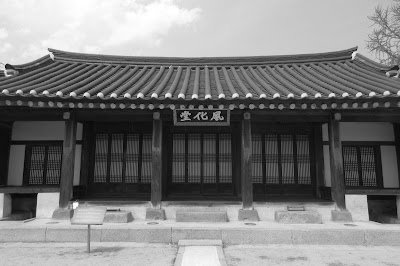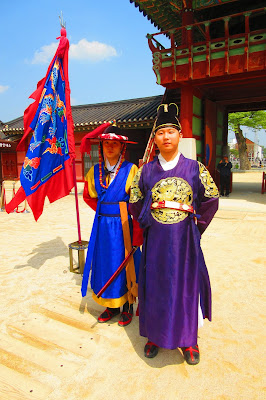I initially wanted to go to Nami Island, but after reading about the historic Hwaseong Fortress I decided to go there instead. The fortress is a UNESCO Heritage Site that surrounds a developed city around 2 hours away from Seoul.
The Fortress
Korea is an old Asian Civilization that has its own culture, design aesthetics and science. It comes as no surprise to see remnants of their former glory in different parts of the country. A friend visited Suwon to see the fortress, so I had an inkling of what to expect when I decided to visit. The fortress isn't as imposing as the Great Wall in China, but it was a remarkable site that hugged a modern town a couple of hours away from Seoul.
Built over two years from 1794 to 1796, this ancient structure was a symbol of the King's filial piety for his father Jangheonseja. It is also an impressive structure from the latter years of the Joseon Dynasty (1392-1910). The King envisioned a pioneer city with a booming economy when he had this fortress built. It became a UNESCO World Cultural Heritage Site in 1997.
Under the guidance of Yu Hyeong-Won and Jeong Yak-Yong, the fortress followed a scientific design to protect the city from invaders. The wall is made of Seokjae and Jeondol bricks with holes at the right size for guns, arrows or long spears. At the time of construction Jeong Yak-Yong invented gyeojunggi which uses a lever to lift heavy stones, resulting in a faster construction time.
I didn't walk all the way around the fortress walls, but the walk to different ends was scenic. One can see remnants of the past, the cannons, watch towers and in some cases, locals dressed in traditional attire walked around.
Suwon isn't as bustling and vibrant as Seoul, but it had a small town charm, and it had this remarkable fortress and wall surrounding it.
Walking around the fortress premises made me imagine the different battles that this relic and its people faced. Amidst the peaceful backdrop (in modern times), this fortress was built to protect an ancient city from invaders centuries ago.
*There is a KW1,000 entrance fee for individuals
Hwaseong Palace
The nearby Hwaseong Palace is a noteworthy destination as it is already near the fortress. This is one of the largest haenggung or temporary palaces where the king and his family stayed in during war.
The structures and layout of the palace was similar to those I've visited in Seoul, but only in a smaller scale.
This small palace doesn't have the same crowds of those you will find in Seoul, but it is still a good place to explore, especially if you like to know more about Korea's ancient past.
What I love about many of the Asian countries I've been to is their preservation of their ancient structures and culture. These are reminders of the past and how a nation moves and transforms itself for the future. The developments that took place in this small city are only a reminder of its former glory. It is like a re-awakening and reconnecting to its past that enabled it to become what it is now.
*There is a KW1,500 entrance fee to enter the palace grounds.
The Fortress
Korea is an old Asian Civilization that has its own culture, design aesthetics and science. It comes as no surprise to see remnants of their former glory in different parts of the country. A friend visited Suwon to see the fortress, so I had an inkling of what to expect when I decided to visit. The fortress isn't as imposing as the Great Wall in China, but it was a remarkable site that hugged a modern town a couple of hours away from Seoul.
Built over two years from 1794 to 1796, this ancient structure was a symbol of the King's filial piety for his father Jangheonseja. It is also an impressive structure from the latter years of the Joseon Dynasty (1392-1910). The King envisioned a pioneer city with a booming economy when he had this fortress built. It became a UNESCO World Cultural Heritage Site in 1997.
Under the guidance of Yu Hyeong-Won and Jeong Yak-Yong, the fortress followed a scientific design to protect the city from invaders. The wall is made of Seokjae and Jeondol bricks with holes at the right size for guns, arrows or long spears. At the time of construction Jeong Yak-Yong invented gyeojunggi which uses a lever to lift heavy stones, resulting in a faster construction time.
I didn't walk all the way around the fortress walls, but the walk to different ends was scenic. One can see remnants of the past, the cannons, watch towers and in some cases, locals dressed in traditional attire walked around.
Suwon isn't as bustling and vibrant as Seoul, but it had a small town charm, and it had this remarkable fortress and wall surrounding it.
Walking around the fortress premises made me imagine the different battles that this relic and its people faced. Amidst the peaceful backdrop (in modern times), this fortress was built to protect an ancient city from invaders centuries ago.
*There is a KW1,000 entrance fee for individuals
Hwaseong Palace
The nearby Hwaseong Palace is a noteworthy destination as it is already near the fortress. This is one of the largest haenggung or temporary palaces where the king and his family stayed in during war.
The structures and layout of the palace was similar to those I've visited in Seoul, but only in a smaller scale.
This small palace doesn't have the same crowds of those you will find in Seoul, but it is still a good place to explore, especially if you like to know more about Korea's ancient past.
What I love about many of the Asian countries I've been to is their preservation of their ancient structures and culture. These are reminders of the past and how a nation moves and transforms itself for the future. The developments that took place in this small city are only a reminder of its former glory. It is like a re-awakening and reconnecting to its past that enabled it to become what it is now.
*There is a KW1,500 entrance fee to enter the palace grounds.



















































No comments:
Post a Comment